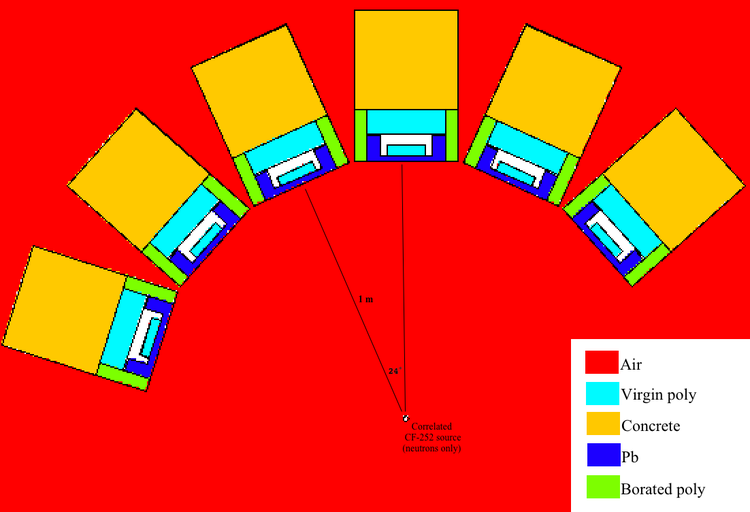Difference between revisions of "CrossTalk"
| Line 12: | Line 12: | ||
Neutron energy deposition from collisions with hydrogen and carbon are converted to electron equivalent light output (MeVee) by MCNP-POLIMI. Neutron collisions that all occur within a pulse collection time of 10 ns of each other are converted to MeVee and cumulated. If the cumulative light output exceeds 0.03 MeVee then it is considered a detection. The value 0.03 MeVee was chosen because it corresponds to a mean neutron energy deposit of 0.2 MeV. | Neutron energy deposition from collisions with hydrogen and carbon are converted to electron equivalent light output (MeVee) by MCNP-POLIMI. Neutron collisions that all occur within a pulse collection time of 10 ns of each other are converted to MeVee and cumulated. If the cumulative light output exceeds 0.03 MeVee then it is considered a detection. The value 0.03 MeVee was chosen because it corresponds to a mean neutron energy deposit of 0.2 MeV. | ||
| − | == | + | ==Detector response== |
The electron equivalent (MeVee) conversion functions for neutrons were measured for plastic (BC 420) scintillators as a function of neutron energy deposit, <math>E_{n}</math>. For deposit on hydrogen the measurements fit the following quadratic function: | The electron equivalent (MeVee) conversion functions for neutrons were measured for plastic (BC 420) scintillators as a function of neutron energy deposit, <math>E_{n}</math>. For deposit on hydrogen the measurements fit the following quadratic function: | ||
Revision as of 21:53, 18 July 2016
Go back MCNP simulations
Geometry
An array of 6 detectors are placed radially at a distance of 1 meter from an uncorrelated 252-CF source. The image below shows a top down view of the simulation geometry. The detector setups have a vertical extent of 30".
Detector physics
The detector physics used in the simulation is MCNP-POLIMI's default treatment for plastic organic scintillators. POLIMI uses electron equivalent light output (MeVee) for simulating detector response. Assuming the detectors have a energy deposition threshold of 0.2 MeV, the corresponding threshold, in electron equivalent light output, becomes 0.03 MeVee.
Summary
Neutron energy deposition from collisions with hydrogen and carbon are converted to electron equivalent light output (MeVee) by MCNP-POLIMI. Neutron collisions that all occur within a pulse collection time of 10 ns of each other are converted to MeVee and cumulated. If the cumulative light output exceeds 0.03 MeVee then it is considered a detection. The value 0.03 MeVee was chosen because it corresponds to a mean neutron energy deposit of 0.2 MeV.
Detector response
The electron equivalent (MeVee) conversion functions for neutrons were measured for plastic (BC 420) scintillators as a function of neutron energy deposit, . For deposit on hydrogen the measurements fit the following quadratic function:
and for deposit on carbon:
Go back MCNP simulations
